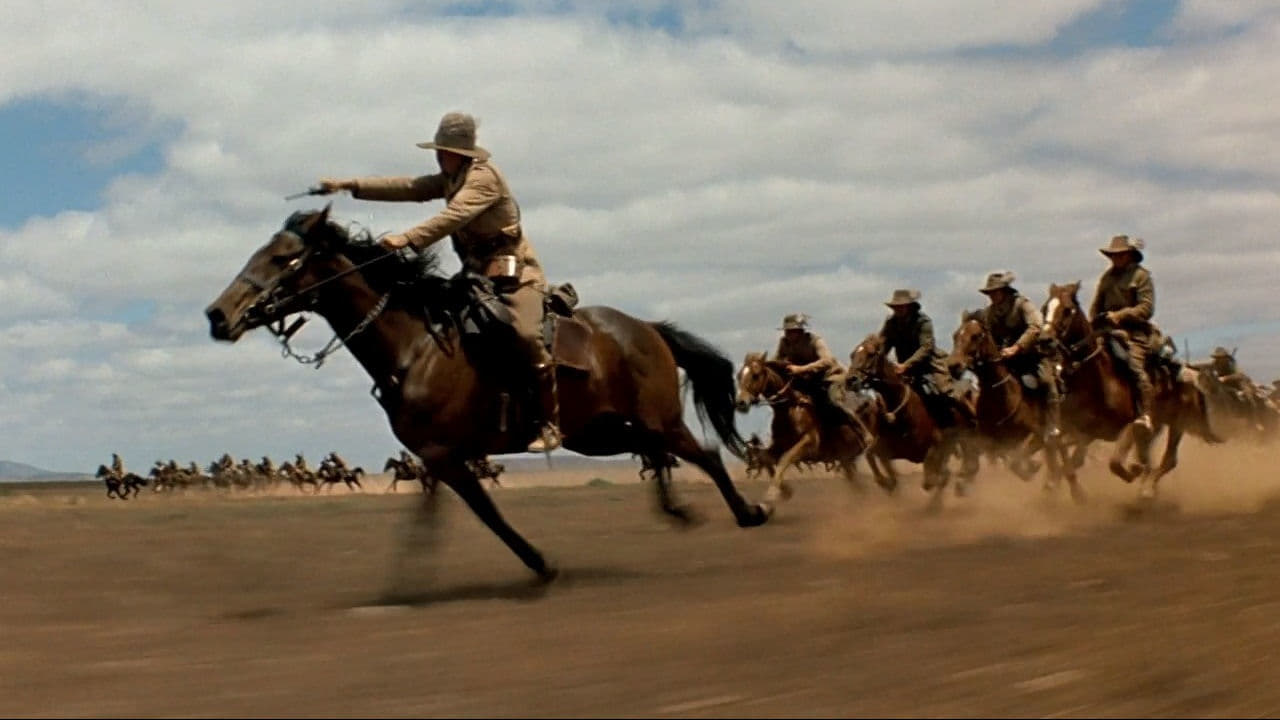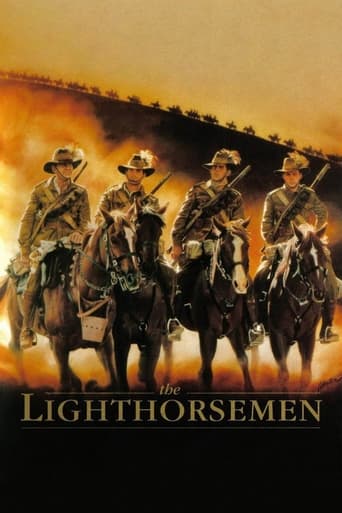

Intense, gripping, stylish and poignant
... View MoreDon't listen to the Hype. It's awful
... View MoreThe film makes a home in your brain and the only cure is to see it again.
... View MoreThere's a more than satisfactory amount of boom-boom in the movie's trim running time.
... View MoreThe "Lighthorseman" works best when the troopers are in the saddle; when they dismount and start talking, the problems begin. No detail of equipment was overlooked in recreating the look of the Light Horse of the Great War, nor were any time-worn clichés from the previous fifty years of war movies.Few cinematic cavalry charges are better than the one at the end of this movie, but if you were hoping for history brought to life with the same depth and sensitivity as Peter Weir's "Gallipoli", this isn't that movie.The story focuses on a section of Light Horsemen: Dave, Scotty, Chiller and Tas played by Peter Phelps, Jon Blake, Tim McKenzie and John Walton. Tony Bonner as their commanding officer, Colonel Bourchier, gives one of the film's best performances as a no-nonsense officer who has earned the respect of his men.When the script deals with the by-play between the troopers the movie has a believable tone, but when it tries to set the scene in historical terms, it gets trickier.Everybody from stiff-backed German officers to stiff upper-lipped British ones, deliver chunks of laborious exposition, much of it speculation about whether the Light Horse will charge or just dismount and crawl through the sand under intense fire. A German officer, who makes the German officers in Errol Flynn's war movies appear as models of subtlety, comments on the Australians, "They are formidable soldiers but the British don't know how to use them". Forced dialogue such as this makes you appreciate how good Weir's "Gallipoli" really is.Dave Mitchell is the central character who finds he is unable to shoot the enemy. After being wounded, he meets Anne, a nurse played by Sigrid Thornton, who helps him come to terms with his problem. Although this is apparently based on a true story, the cinematic déjà vu is overwhelming. The shots of the Light Horse on the move are impressive and the final charge is exciting, but there could be a little too much use of the zoom lens in "The Lighthorsemen".Our visual knowledge of historic events is shaped by images such as the black and white photography from the last half of the 19th Century followed by film of varying quality through the first half of the 20th Century. Although the zoom lens had been around for about fifty years, it didn't come into it's own until the early 1960's when the problem of focus was solved. You don't see much use of the zoom in movies and documentaries up until then. Although filmmakers could claim they are bringing history to life in a modern and immediate way, I feel that a period film that uses the zoom extensively tends to distance itself from the look and feel of the times in which it is set. There is no noticeable use of the zoom in John Ford's cavalry trilogy; films that effortlessly capture the period in which they are set.In World War 1, The Australian Light Horse and the New Zealand Mounted Rifles comprised the British Army's main mobile strike arm in the Sinai and Palestine Campaign. Before tanks, these mounted troops were the British army's equivalent of the next war's Panzers, and Beersheba was their most spectacular Blitzkrieg. Despite the brashness, "The Lighthorsemen" goes some way towards giving these men, arguably Australia's greatest generation, some belated homage.
... View MoreThis impressive flick is based on a true story and most of the characters in the film were based on real people and dealing with the continued coming of age of the Australian nation and its soldiers . The film follows Four Australians, Frank (Gary Sweet), Scotty (Jon Blake who was injured in a car accident and he suffered permanent paralysis and brain damage until his recent death) an Irish-Australian, Chiller (Tim McKenzie) and Tas (John Walton) in Palestine in 1917, part of the 4th Light Horse Brigade of the British and Commonwealth Dominion forces. When Frank is wounded and dies of his wounds, he is replaced by Dave (Peter Phelps). Dave finds himself unable to fire his weapon in combat and is transferred to the Medical Corps, where he will not need to carry a weapon, but where he will still be exposed to the fighting . After the Second Battle of Gaza ended in complete failure, General Archibald Murray (Tony Bonner) , the commander in chief of the British forces in Egypt and Palestine, was replaced by the distinguished cavalry commander, General Edmund Allenby (Anthony Hawkins) , formerly the commander of the British Third Army on the Western Front to carry out the British plan the capture of Beersheba. During an attack by Turkish cavalry, Major Richard Meinertzhagen (Anthony Andrews) deliberately leaves behind documents indicating that the attack on Beersheba will only be a diversion. At the ending there takes place the Battle of Beersheba (Turkish: Birüssebi Savaşı) that was one critical element of a wider British offensive, known as the Third Battle of Gaza, aimed at breaking the Ottoman defensive line that stretched from Gaza on the Mediterranean shore to Beersheba ; it took place on 31 October 1917, as part of the Sinai and Palestine campaign during World War I . Notable was the charge of the Australian 4th Light Horse Brigade, which covered some 6 kilometres (3.7 mi) to overrun and capture the last remaining Ottoman trenches, and secure the surviving wells at Birüssebi . The total losses incurred by the Desert Mounted Corps was 53 men killed and 144 wounded. The heaviest Allied losses were suffered by the British infantry of XX Corps, which lost 116 killed in action, although the total number of men killed during the battle from the British force was far greater, totalling 171 men.It follows in the wake of other Australian New Wave war movies such as Breaker Morant (1980), Gallipoli (1981), and the 5-part TV series Anzacs (1985). Recurring issues of these films include the Australian identity , such as mateship and friendship , ANZAC spirit , the loss of innocence in war, and breathtaking battles spectacularly filmed . Acceptable acting from main and support cast including prestigious Aussie/English actors such as Anthony Andrews , Shane Bryant , Sigrid Thornton , Tony Bonner , Gary Tweed , Bill Kerr , though none of the performances are really bad, but none are very good . Gorgeous outdoors are well photographed by cameraman Dan Cundey . Despite being set in Palestine and Egypt, the film was shot entirely on location in Victoria and Hawker, South Australia . Rousing and emotive musical score was composed by Mario Millo. It was nominated for Best Achievement in Cinematography and won an Australian Film Institute award in 1988 for Best Original Music Score and another for Best Achievement in Sound. It grossed a lot of money at the box office in Australia . Sensational directorial by the notorious filmmaker Simon Wincer, a Western expert, as he emigrated Hollywood and subsequently directed to Tom Selleck in ¨Monte Walsh¨ , ¨Crossfire trail¨ and ¨Quigley Down Under¨ to Paul Hogan in ¨Relampago Jack¨ and ¨Cocodrile Dundee in L.A.¨ and usually directs episodes for TV mini-series, such as ¨Into the West¨, ¨The Ponderosa¨ , ¨Lonesome Dove¨ and ¨The adventures of young Indiana Jones¨ , among others . Rating: good for the sensitive direction and proficient film-making ; the result is a sort of pacifist-aggressive war adventure . Worthwhile watching .
... View MoreThe "Charge of the Light Horse" has gone down in the annals of legend, as indeed of history. This, the definitive film of the event so far, is based on the true story of one couple's involvement in the events of the 1917 desert campaign. Like the earlier "Forty Thousand Horsemen" (1940), a very similar film in many respects, it leads up to the momentous charge on Beersheeba with style, tension and humour.It was partly a starring vehicle for the wonderfully charismatic action hero Jon Blake, whose sad incapacitation has robbed Australian cinema of one of its shining lights.The scene of the charge is superbly choreographed and filmed, and deserves to be right up there with the chariot race scene from Ben Hur.I cannot conceive of anything more scary than being on the wrong end of a cavalry charge, and this will have you out of your seat.I personally rate this as the best film (of any genre) I have ever seen.
... View MoreThe Lighthorsemen is a true delight of a movie. It is unpretentious, well-shot, fast-paced, entertaining and interesting from the start.The movie is slow when it needs to be as in when the Lighthorsemen have to take their horses to the brink of exhaustion in order to surprise the German/Turk occupants of Jacob's Well.The characters are mostly very well-defined and you feel for them as the movie moves on.The charge scene is the highlight of the film. You feel as though you are on one of the horses racing into the sights of the entrenched Turks. As the bombs explode and the bullets fly, you can't help but feel the urge to keep your head down. The sight of several hundred charging horses is awe-inspiring.This movie can be hard to find, but if you do, you have a winner.
... View More